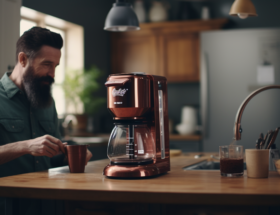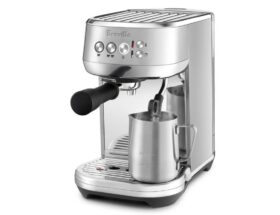
Why Does Oat Milk Curdle in Coffee? Tips to Prevent Curdling
Oat milk: beloved for its creamy texture and dairy-free delight. But hold up – the dreaded curdling in coffee? Yep, it’s a buzzkill many have faced. Don’t let your java joy get soured! This blog gets to the bottom of why oat milk curdles in coffee and serves up savvy solutions to keep your cup smooth and sensational. Morning coffee woes, meet their match!
Table of Contents
Oat Milk and Coffee: A Match Made in Heaven?
For coffee aficionados who prefer a non-dairy alternative, oat milk has quickly emerged as a popular choice. With its creamy texture and subtle sweetness, oat milk adds a touch of indulgence to your morning cup of joe. However, there’s one issue that can occasionally put a damper on this heavenly pairing: curdling.
Why Does Oat Milk Curdle in Coffee?
The curdling of oat milk in coffee is primarily due to the difference in acidity between the two. Coffee is naturally acidic, especially if it’s brewed strong. On the other hand, oat milk tends to be slightly alkaline in nature.
When these two substances come into contact, the acidity of the coffee can cause the proteins in the oat milk to coagulate and form lumps or curds. This curdling effect is more likely to happen if you pour oat milk directly into hot coffee or expose it to high temperatures for an extended period.
Tips to Prevent Curdling
Don’t worry! There are several strategies you can employ to prevent oat milk from curdling in your coffee and enjoy a smooth, creamy beverage every time:
- Preheat Your Coffee Cup: Before pouring your coffee, preheat your cup with hot water. This helps to minimize the temperature difference between the coffee and oat milk, reducing the chances of curdling.
- Gradually Add Oat Milk: Rather than pouring oat milk directly into your hot coffee, try adding it gradually. Start with a small amount, like a teaspoon, and gently mix it into the coffee. Repeat the process until you’ve achieved your desired creaminess. This method helps the oat milk gradually adjust to the temperature of the coffee, preventing curdling.
- Mix Oat Milk With Warm Coffee: If you prefer your coffee piping hot, consider warming the oat milk slightly before adding it to your mug. Heat the oat milk in a separate container, and then slowly pour it into your warm coffee while stirring gently. This approach reduces the temperature difference and minimizes the likelihood of curdling.
- Choose a Barista Edition Oat Milk: Some brands offer a “barista edition” oat milk specifically designed to withstand the high temperatures and acidity of coffee. These varieties tend to have additives or stabilizers that help prevent curdling. Check the packaging for the barista-friendly claim or do some research to find the most suitable option for your coffee preparation.
Experiment and Find Your Perfect Cup
With these tips in mind, don’t be afraid to experiment with different brewing methods, coffee temperatures, and oat milk brands to find your perfect cup. Remember, the curdling issue, though not ideal, doesn’t mean you can’t enjoy your oat milk coffee. It just takes a little adjustment and finding the right technique that works for you.
Did you know that oat milk is made by soaking oats in water and then blending and straining the mixture? This process creates a creamy and flavorful alternative to dairy milk. Oat milk's rising popularity can be attributed to its smooth texture and ability to froth, making it perfect for coffee lovers. However, due to its unique composition, oat milk can sometimes curdle when mixed with coffee.
So, go ahead and savor your creamy oat milk coffee without worrying about those unappetizing curds. After all, there’s nothing quite like the perfect combination of a velvety smooth cup of coffee topped with the rich, creamy goodness of oat milk!
Step-by-Step Guide: Preventing Oat Milk Curdling in Coffee
Step 1: Choose the Right Oat Milk
Choosing the right oat milk for your coffee can make all the difference in preventing curdling. Look for oat milk brands that are specifically designed for use in hot beverages, as they often contain additional stabilizers to prevent curdling. Additionally, opt for unsweetened oat milk, as added sugars can also contribute to curdling.
Suggested brands: Oatly Barista Edition, Pacific Foods Barista Series, Califia Farms Oat Milk
Step 2: Prepare Your Coffee First
To minimize the chances of oat milk curdling in your coffee, it’s important to prepare your coffee first. Brew your coffee to your desired strength and let it cool slightly before adding any oat milk. This allows the coffee to stabilize and reduces the likelihood of curdling when combined with the oat milk.
Step 3: Warm the Oat Milk
Before adding oat milk to your coffee, warm it gently on the stove or in the microwave. Heating the oat milk slightly helps to stabilize its proteins and reduces the risk of curdling when it comes in contact with hot coffee. Be careful not to overheat the milk, as this can also cause curdling.
Step 4: Mix Gradually
Instead of pouring the oat milk directly into your coffee, try adding it gradually while stirring continuously. This allows the oat milk and coffee to mix more evenly, reducing the chances of curdling. As you continue to stir, the proteins in the oat milk will have a better chance of dispersing throughout the coffee.
Step 5: Use a Frother or Blender
If you’re finding it challenging to prevent oat milk curdling in your coffee, consider using a frother or blender. Frothing or blending the oat milk before adding it to your coffee can help to break down any clumps and create a smoother texture. This method ensures better integration of the oat milk and coffee, minimizing the risk of curdling.
Step 6: Adjust the Coffee Temperature
If you’re still experiencing issues with oat milk curdling, try adjusting the temperature of your coffee. Some oat milk brands may be more prone to curdling at higher temperatures. Experiment by slightly reducing the temperature of your coffee and see if it helps to prevent curdling with your particular brand of oat milk.
Step 7: Experiment with Alternative Milk Options
If all else fails, you can always explore alternative milk options that are less likely to curdle in coffee. Consider trying other plant-based milks like almond milk, soy milk, or coconut milk. These alternatives may behave differently when mixed with coffee and offer a creamy texture without the curdling concerns.
By following these steps and experimenting with different techniques, you can enjoy a smooth, creamy cup of coffee without the frustrating issue of oat milk curdling. Remember, practice makes perfect, so don’t be discouraged if it takes a few tries to find the perfect method for your taste.
Wrap Up
In conclusion, oat milk curdling in coffee can be a frustrating issue for oat milk lovers. Understanding the science behind the curdling process and implementing preventive measures can help ensure a smooth and creamy cup of coffee every time. From choosing the right oat milk to properly mixing it with coffee, these tips and techniques will make your oat milk coffee experience a delight.
Remember to experiment with different oat milk brands and types to find the one that works best for you. And don’t forget to share your experience and tips in the comments below!
If you’re interested in exploring more coffee-related topics, be sure to check out these articles:
– How to Vietnamese Coffee: The Strong & Bold Coffee– How to Hario V60: The Ultimate Guide to Making Perfect Coffee– How to Siphon Coffee: The Slow and Elegant Way to Brew a Perfect Cup– How to Aeropress: The Ultimate Guide to Making Amazing Coffee at Home
And many more on our website Ten Coffees. Happy brewing!









